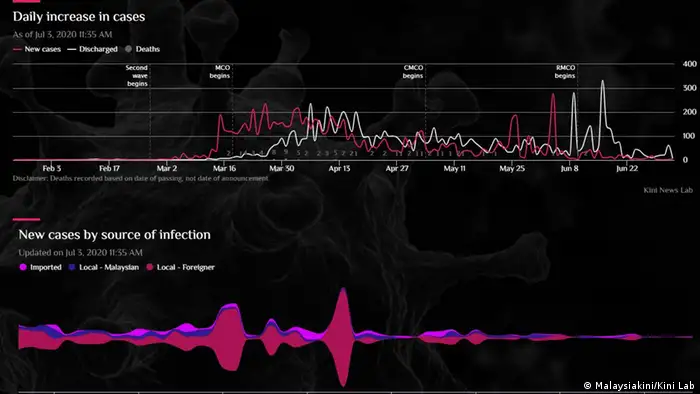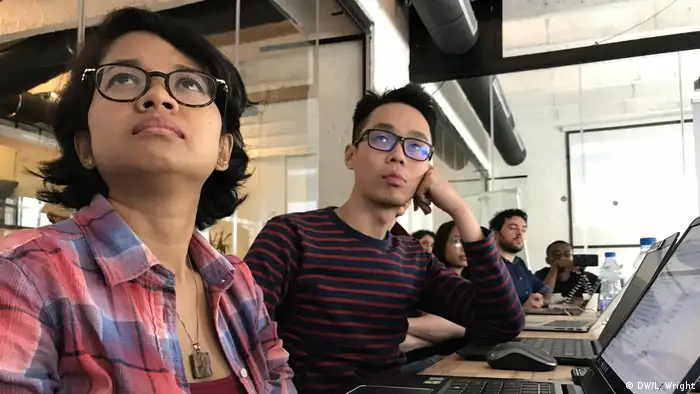In focus
How pushing for transparency helped Malaysians navigate COVID-19
When COVID-19 hit Malaysia, journalists from online news site Malaysiakini had to request data from the government every day. Dataship fellows Aidila Razak and Lee Long Hui made Malaysia’s first online COVID-19 tracker.
For the first two months of the COVID-19 outbreak in Malaysia, most Malaysians weren't paying much attention. There were fewer than 30 cases isolated among known clusters and life went on as normal.
But things changed dramatically on March 9, when neighboring Brunei reported its first case — a man who had attended a religious gathering in the Malaysian capital Kuala Lumpur alongside about 16,000 others. It became the epicenter of the outbreak and would become central to Malaysian lives.
Although the government was holding press conferences and releasing press statements on the outbreak on an almost daily basis, information was either scattered or lacked granularity.
For example, the daily press statements would state the number of new cases recorded and the number of cases discharged but did not specify where, which demographics were involved, or any other data which could help Malaysians make sense of the outbreak.
However, some of this information is available through various other sources — news articles, social media posts from different news agencies, and so on. This includes information on how to stay safe and who to contact to get help.
Pushing for greater transparency
There was a glaring need for this information to be collated and centralized, and presented in a way that would help Malaysians gain clarity in an increasingly confusing and frightening time.
This need was quickly identified by the Kini News Lab, a small team of technologists and journalists at Malaysia’s top news website, Malaysiakini. On March 10, just as COVID-19 infections shot up in Malaysia, Malaysiakini’s COVID-19 tracker page went online.
At the time it was launched, the star of the tracker page was an interactive map, which allowed Malaysians to see places COVID-19 patients had visited up to 14 days before they were diagnosed. The information was collated through publicly available resources — such as announcements from building management and employers and sometimes through declarations from patients shared on their public social media accounts. However, in the era of rampant disinformation, each location marked on the map was verified.
Malaysiakini became the first website in the country to provide this service, and inspired many others to follow suit. Since then, other Malaysian news websites have developed their own versions of the COVID-19 tracker, based on the Kini News Lab product, while data analytics companies have followed suit.
The tracker also inspired Kenyan data analytics organization Odipo Dev to help newsrooms in Kenya build similar interactive features which track the outbreak there. This cross-continental connection was possible through the DW Akademie’s Dataship data journalism fellowship, of which Kini News Lab and Odipo Dev members were a part of.
A public health service
Although it started with just one page, the Kini News Lab COVID-19 tracker page now not only tracks the movement of the outbreak, but compares it with hospital resources, provides breakdowns of cases all the way to sub-district levels, gives real time analysis of clusters of cases and even includes tools to compare how Malaysia is doing compared to other countries.
It was also a key resource for Malaysians to understand the rules of the lockdown and where to get help when information from government agencies was unclear, or even when government websites were inaccessible.
Since its launch, the tracker page has garnered 18 million unique page views, reaching a top of about 780,000 views a day. Today, as Malaysia goes into the recovery phase of the outbreak, the page is still viewed about 90,000 times a day.
The viewership indicates the project is a success, but a greater measure of success is perhaps how Malaysiakini and the Kini News Lab has pushed for greater data transparency from the Ministry of Health.
When Malaysiakini first started reporting on the coronavirus pandemic, the government was not releasing daily figures. Malaysiakini journalists had to go directly to the government and request the latest data each day.
Today, the data which Malaysiakini reporters had to repeatedly ask for is provided by the government voluntarily. In fact, the government recently launched a website for this purpose.
Trackers in additional languages
The number of cases recorded in Malaysia is much lower these days, as we return to the (new) normal, but the landscape of the outbreak has changed. Most of the cases detected now consist of blue collar migrant workers from Nepal, Bangladesh, Myanmar, India and the like. There are about 2 million such workers in Malaysia, but there are no information resources in their language.
As such, with DW Akademie support, the next phase of the tracker project will be to translate it into Nepali, Burmese and Bengali, the three languages most spoken by blue collar migrant workers in Malaysia after Bahasa Indonesia, which is similar to Malaysia’s local language.
The team is working fast to launch the three additional languages soon, as information can mean life or death. But in the best case scenario, the trackers will have a short shelf life, and Malaysia will soon be able to declare itself COVID-19 free.
Aidila Razak is a Special Reports Editor at Malaysiakini. She leads the COVID-19 tracker project with Malaysiakini Assistant Editor Lee Long Hui. Both are members of the DW Data Journalism Fellowship (Dataship).
- Date 10.07.2020
- Author Aidila Razak
- Feedback: Send us your feedback.
- Print Print this page
- Permalink https://p.dw.com/p/3f4He
- Date 10.07.2020
- Author Aidila Razak
- Send us your feedback.
- Print Print this page
- Permalink https://p.dw.com/p/3f4He




